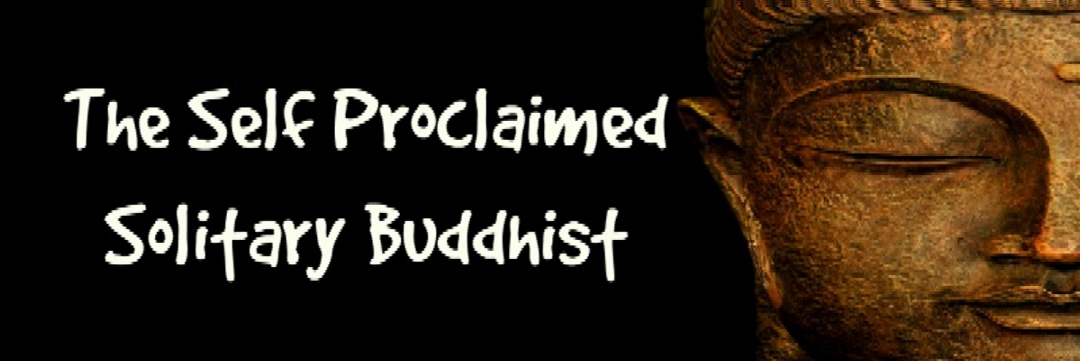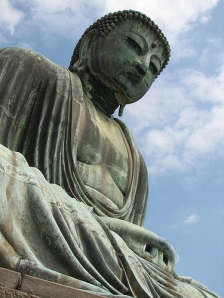The Four Noble Truths
This is the very first teaching the Buddha offered following his enlightenment. The three major branches of Buddhism, Theravada (Hinayana), Mahayana, and Vajrayana (Tantric), generally share very similar interpretations of The Four Noble Truths, though in some schools they are emphasized more than others. Mahayana and Vajrayana interpretations tend to add an extra element or understanding rather than revise. I speculate that where they are less emphasized in favor of other more intellectual concepts, such as emptiness or non-self.
Theravada
The Four Noble Truths are presented in the Dhammacakkappavattana Sutta, “Setting the Wheel of Dhamma (Dharma) in Motion” in the Pali Cannon. Dukkha sometimes translated as “suffering” is often also called “stress” or “unsatisfactoriness.” I’ll use the word suffering as the most common translation of the original term.
The difference between The Four Noble Truths and so many other religious doctrines is that these are not beliefs. Rather, this is a description of the way the world exists. Likewise, one doesn’t have to believe in gravity to be affected by it at all times. Suffering is, it’s as simple as that.
The Truths are traditionally rendered as:
- The Truth of Suffering (Dhukka): All living beings suffer.
- The Truth of the Cause of Suffering (Samudaya): Suffering is caused by desire.
- The Truth of the Cessation of Suffering (Nirodha): Suffering can end.
- The Truth of the Path to End Suffering (Magga): Following the Noble Eightfold Path leads to the end of suffering.
Some non-believers say that by starting out with suffering, Buddhism presents a basically pessimistic view. However, study of any of the world’s great religions will by and large reveal that they are all attempts to answer that same question: Why do we suffer? In the Abrahamic faiths this is explained by human beings’ estrangement from God and God’s will, so naturally they start out by talking about God. In Buddhism, we can skip that step, seeing as the very idea of a singular creator god was unknown in India during the Buddha’s lifetime (though the Buddha did address the then current conception of Brahma, which is slightly different). So rather than being pessimistic, The Four Noble Truths address the problem directly, like a doctor who must first understand the disease in order to offer a cure. Furthermore, the Third Noble Truth, is entirely uplifting. It tells us suffering is optional and, moreover, that we have the power to end it ourselves. How much more optimism do we need?
Notable Theravada teachers have this to say about The Four Noble Truths:
“Each of these truths entails a duty: stress is to be comprehended, the origination of stress abandoned, the cessation of stress realized, and the path to the cessation of stress developed. When all of these duties have been fully performed, the mind gains total release. … Thus the study of the four noble truths is aimed first at understanding these four categories, and then at applying them to experience so that one may act properly toward each of the categories and thus attain the highest, most total happiness possible.” – Thanissaro Bhikku
“Now the Four Noble Truths are: there is suffering; there is a cause or origin of suffering; there is a end of suffering; and there is path out of suffering which is the Eightfold Path. Each of these Truths has three aspects so all together there are twelve insights. In the Theravada school, an arahant, a perfected one, is one who has seen clearly the Four Noble Truths with their three aspects and twelve insights. ‘Arahant’ means a human being who understands the truth; it is applied mainly to the teaching of the Four Noble Truths. … We use these Four Noble Truths for our development. We apply them to ordinary things in our lives, to ordinary attachments and obsessions of the mind. With these truths, we can investigate our attachments in order to have the insights. Through the Third Noble Truth, we can realize cessation, the end of suffering, and practice the Eightfold Path until there is understanding. When the Eightfold Path has been fully developed, one is an arahant, one has made it. Even though this sounds complicated – four truths, three aspects, twelve insights – it is quite simple. It is a tool for us to use to help us understand suffering and non-suffering.” – Ajahn Sumedho
“Shortly after his Awakening, the Buddha delivered his first sermon, in which he laid out the essential framework upon which all his later teachings were based. This framework consists of the Four Noble Truths, four fundamental principles of nature (Dhamma) that emerged from the Buddha’s radically honest and penetrating assessment of the human condition. He taught these truths not as metaphysical theories or as articles of faith, but as categories by which we should frame our direct experience in a way that conduces to Awakening. … Because of our ignorance (avijja) of these Noble Truths, because of our inexperience in framing the world in their terms, we remain bound to samsara, the wearisome cycle of birth, aging, illness, death, and rebirth. Craving propels this process onward, from one moment to the next and over the course of countless lifetimes, in accordance with kamma (Skt. karma), the universal law of cause and effect. … The Buddha discovered that gaining release from samsara requires assigning to each of the Noble Truths a specific task: the first Noble Truth is to be comprehended; the second, abandoned; the third, realized; the fourth, developed.” – John T. Bullit
“…the fundamental meaning of the first noble truth, is the unsatisfactoriness and radical inadequacy of everything conditioned, owing to the fact that whatever is conditioned is impermanent and ultimately bound to perish. … Itself the product of ignorance, an unawareness of the true nature of things, craving springs up wherever there is the prospect of pleasure and enjoyment, bringing along with it the multitude of mental defilements responsible for so much human misery: greed and ambition, hatred and anger, selfishness and envy, conceit, vanity and pride. … Since suffering arises through craving, with the destruction of craving, suffering too must cease: a relationship as tight and inevitable as logical law. The state that then supervenes, the goal of all striving for Theravada Buddhism, is nirvana, the unconditioned, the deathless, the imperishable peace beyond the round of birth and death.” – Bhikku Bodhi (An Introduction to the Buddha and His Teachings, pages 62-64)
Mahayana
Mahayana and Theravada teachings largely agree in their interpretation of The Four Noble Truths. Where they differ is in their use. While Theravada sees realization of the Truths (in all their simplicity and complication and via various methods of mental cultivation) as fully effective for achieving arhat-ship (the endgame of Theravada practice, amounts to buddha-hood or bodhisattva-hood in Mahayana), Mahayana holds that the Truths and the Path were merely “the first turning of the wheel of Dharma” (Pali: Dhamma). In other words, the Buddha saved his “highest and best” teaching for later. One of the most revered Mahayana texts, the Lotus Sutra (Sanskrit: Saddharma Puṇḍarīka Sūtra), states:
In early passages, the Buddha tells the assembly that his earlier teachings were provisional. People were not ready for his highest teaching, he said, and had to be brought to enlightenment by expedient means. But the Lotus represents the final, highest teaching, and supersedes all other teachings.
We suffer, the Buddha says, because the nature of existence is impermanent (when we want permanence) and permeated by self (when no such self exists). As Bikkhu Bodhi has sad, the nature of things are “conditioned,” that is, the result of causation and therefore subject to change. Rather, all things are interconnected, interdependent, and co-arising. This is where Mahayana makes the leap from enlightenment (arhat-ship) for oneself to enlightenment for all sentient beings, which is the goal of the bodhisattva. Seeing as we’re all interconnected, we can’t really get enlightened unless everyone gets enlightened. So the bodhisattva seeks, and at a certain point attains, enlightenment, but then reenters the stream of rebirth, the world of samsara, to teach other sentient beings until such time as we all achieve enlightenment, i.e. Third Noble Truth: the cessation of suffering.
Now, some Mahayana teachings may even seem to deny the Four Noble Truths, stating that they are not truths at all. After all, how can suffering be a “truth” or “law” of existence if we have the ability to stop it? Some Mahayana teachers characterize the four noble truths thus:
- Suffering is not permanent, but the Buddha is.
- The origin of suffering is not eternal, but the Buddha is.
- The cessation of suffering is not unchanging, but the Buddha is.
- The path to the end of suffering is not peaceful, but the Buddha is.
In these sentences, Buddha may be exchanged with buddha-nature, that is, the inherent or potential enlightenment within all sentient beings. The Mahayana are consistently more optimistic on a person’s ability to attain buddha-hood, often in a single lifetime, than the Theravadans. Scholars speculate that the Mahayana trend to stress buddha-hood for all contributed to its popularity.
Here is what some notable Mahayana teachers have to say on the issue:
“After realizing complete, perfect awakening (samyak sambodhi), the Buddha had to find words to share his insight. He already had the water, but he had to discover jars like the Four Noble Truths and the Nobel Eightfold Path to hold it. … The First Noble Truth is suffering (dukkha). The root meaning of the Chinese character for suffering is ‘bitter.’ Happiness is sweat; suffering is bitter. We all suffer to some extent. … The Second Noble Truth is the origin, roots, nature, creation, or arising (samudaya) of suffering. After we touch our suffering, we need to look deeply into it to see how it came to be. … The Third Noble Truth is the cessation (nirodha) of creating suffering by refraining from doing the things that make us suffer. This is good news! The Buddha did not deny the existence of suffering, but he also did not deny the existence of joy and happiness. … The Fourth Noble Truth is the path (marga) that leads to refraining from doing the things that cause us to suffer. This is the path we need the most.” – Thich Nhat Hanh, The Heart of Buddha’s Teachings, p. 9-11
“It is important to understand that an intellectual grasp of the four noble truths is not considered sufficient; following the Buddhist path requires great effort on the part of the individual, leading to a realization of the truths for oneself. This realization requires the practice of meditation and is associated with Buddhist monastic practice rather than lay Buddhism. Although Mahayana Buddhism accepts the four noble truths as the basic teachings of the Buddha, they are not generally a primary topic of Mahayana teaching, nor are they typically the focus of Mahayana meditative practices. While lay followers of Theravada Buddhism are familiar with the four noble truths, most Mahayana Buddhists are not.” – Helen Josephine Baroni, The Illustrated Encyclopedia of Zen Buddhism, p. 98
Vajrayana
Vajrayana recognizes The Four Noble Truths as the first teaching of the Buddha. The Vajrayana characterizes itself as a “swift path” (the word “Vajrayana” is sometimes translated as “lightning vehicle”). “This swiftness of the Vajrayana path does not derive from a profound philosophical outlook, but because of the practice of most profound and sophisticated meditative methods,” according to the Institute of Tibetan Classics. Vajrayana, sometimes called Tantra, Tantric Buddhism, or Esoteric Buddhism, holds the same Bodhisattva ideal as the Mahayana, however, it takes skillful means (upaya) to an unprecedented level through complex ritual, various esoteric forms of yoga and meditation, and the recognition of both relative and ultimate truth. Even The Four Noble Truths are subject to understanding via the Two Truths (relative and ultimate).
Suffering is a relative truth. Nirvana (the cessation of suffering and state of enlightenment) is the ultimate truth. Ignorance is a relative truth. Buddha-nature is the ultimate truth. The Vajrayana therefore is a path by which one must cultivate one’s apprehension of the ultimate truth. One becomes a buddha by being a buddha. For this, Vajrayana employs a multitude of techniques including (but by no means limited to) Dzogchen, ngondro, deity meditation, mandalas, and Mahamudra.
Prominent Vajrayana teachers have this to say on the subject:
“When the great universal teacher Shakyamuni Buddha first spoke about the Dharma in the noble land of India, he taught the four noble truths: the truths of suffering, the cause of suffering, the cessation of suffering and the path to the cessation of suffering. … We experience many different types of suffering. All are included in three categories: the suffering of suffering, the suffering of change and all-pervasive suffering. … Now, desiring liberation from the first two categories of suffering is not the principal motivation for seeking liberation; the Buddha taught that the root of the three sufferings is the third: all-pervasive suffering. … This third, all-pervasive, suffering is under the control of karma and the disturbing mind … of previous lives: anger and attachment arise simply because we have these present aggregates. The aggregate of compounding phenomena is like an enabler for us to generate karma and these disturbing minds… Even if you take your own life, this life, you will have to take another body that will again be the basis of suffering. If you really want to get rid of all your suffering, all the difficulties you experience in your life, you have to get rid of the fundamental cause that gives rise to the aggregates that are the basis of all suffering. Killing yourself isn’t going to solve your problems.” – The Dalai Lama
“If the Buddha had taught his disciples principally by demonstrating his miraculous abilities and various powers, it would not have been the best way to establish them on the path of liberation. The best way to bring them to that wisdom and liberation was to point out the very truth of things; to point out the way things really are. So this is what he did: He showed the truth through the four noble truths and the two truths (relative and absolute truth). By seeing the way things really are, the students learned how to eliminate their mistakes and their delusions. Eliminating one’s mistakes and delusions automatically destroys the causes of one’s suffering and hardships. This allows one to progressively reach the state of liberation and great wisdom. That is why the four noble truths and the two truths are the essence of the first teachings of the Buddha.” – Thrangu Rinpoche
The Solitary Buddhist Summary
So what does all of this BOIL (I'm from South Louisiana, we BOIL everything) down to?
1. Life sucks.
2. Life sucks because we want stuff, more stuff, it's never the right stuff.
3. Life doesn’t have to suck.
4. There’s a Path to free us from the suckiness of life.
2. Life sucks because we want stuff, more stuff, it's never the right stuff.
3. Life doesn’t have to suck.
4. There’s a Path to free us from the suckiness of life.
Basically, pain is a factor of living. You stub your toe, you slam your hand in a car door, you get old, sick, and you die. We all do it. The suffering bit, that’s optional. You curse at the coffee table you stubbed your toe on. You yell at the spouse who closed the car door too quickly. You hate fate or God or life when you get old and sick. We all fear death. We don’t have to curse, get angry, hate, or fear. All we have to do is stop wanting the coffee table to have magically been elsewhere, our spouse to have been a little more attentive, stop not wanting to age or get sick, and not to die.
First of all, what’s done is done. We can still work for a better future, but there’s no use getting pissed about the past or stressing about the future. Ask your spouse to be more careful when closing the car door, but don’t spread the suffering around in such a way that they get mad at you for being mad at them for what was clearly an accident. And there’s no use getting upset about things we can’t change. We’re all gonna die. Sure, we can work to be healthy, do everything right, and try to live a good long life (or get hit by a bus tomorrow). But we can't avoid the fact we all go through some form of suffering and eventually die.
So you don’t want to suffer? Who does? The path for that (The Eightfold Path) is one of right view and thinking, right speech, action, and livelihood, and right diligence/effort, mindfulness, and concentration. Basically, do good not only for your own sake, but for others as well, because we’re all in this together. Doing good will make you feel good and helping others will make you feel your own problems less. It works. I’ve tried it.
Now, there’s one last conundrum. How do you stop suffering if wanting leads to suffering but you want to stop suffering and if you didn’t want to stop suffering you wouldn’t be trying to stop wanting? Well, the Buddhists have a saying: You only need a boat to cross an ocean. After you get to the other side, you leave the boat behind. So that one kind of desire, the desire to end suffering, can be useful.
May all beings have happiness and the cause of happiness.
May they be free of suffering and the cause of suffering.

























